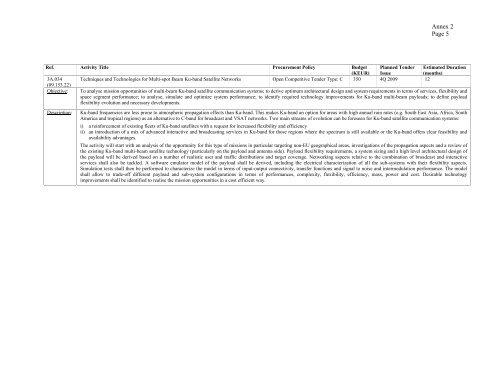ARTES-5.1 â ESA Telecom Technology Workplan ... - Emits - ESA
ARTES-5.1 â ESA Telecom Technology Workplan ... - Emits - ESA
ARTES-5.1 â ESA Telecom Technology Workplan ... - Emits - ESA
- No tags were found...
You also want an ePaper? Increase the reach of your titles
YUMPU automatically turns print PDFs into web optimized ePapers that Google loves.
Annex 2Page 5Ref. Activity Title Procurement Policy Budget(KEUR)Planned TenderIssueEstimated Duration(months)3A.034 Techniques and Technologies for Multi-spot Beam Ku-band Satellite Networks Open Competitive Tender Type: C 350 4Q 2009 12(09.153.22)Objective: To analyse mission opportunities of multi-beam Ku-band satellite communication systems; to derive optimum architectural design and system requirements in terms of services, flexibility andspace segment performance; to analyse, simulate and optimize system performance; to identify required technology improvements for Ku-band multi-beam payloads; to define payloadflexibility evolution and necessary developments.Description:Ku-band frequencies are less prone to atmospheric propagation effects than Ka-band. This makes Ku-band an option for areas with high annual rain rates (e.g. South East Asia, Africa, SouthAmerica and tropical regions) as an alternative to C-band for broadcast and VSAT networks. Two main streams of evolution can be foreseen for Ku-band satellite communication systems:i) a reinforcement of existing fleets of Ku-band satellites with a request for increased flexibility and efficiencyii) an introduction of a mix of advanced interactive and broadcasting services in Ku-band for those regions where the spectrum is still available or the Ku-band offers clear feasibility andavailability advantages.The activity will start with an analysis of the opportunity for this type of missions in particular targeting non-EU geographical areas, investigations of the propagation aspects and a review ofthe existing Ku-band multi-beam satellite technology (particularly on the payload and antenna side). Payload flexibility requirements, a system sizing and a high level architectural design ofthe payload will be derived based on a number of realistic user and traffic distributions and target coverage. Networking aspects relative to the combination of broadcast and interactiveservices shall also be tackled. A software emulator model of the payload shall be derived, including the electrical characterization of all the sub-systems with their flexibility aspects.Simulation tests shall then be performed to characterize the model in terms of input-output connectivity, transfer functions and signal to noise and intermodulation performance. The modelshall allow to trade-off different payload and sub-system configurations in terms of performances, complexity, flexibility, efficiency, mass, power and cost. Desirable technologyimprovements shall be identified to realise the mission opportunities in a cost efficient way.
















